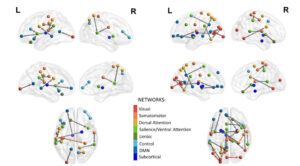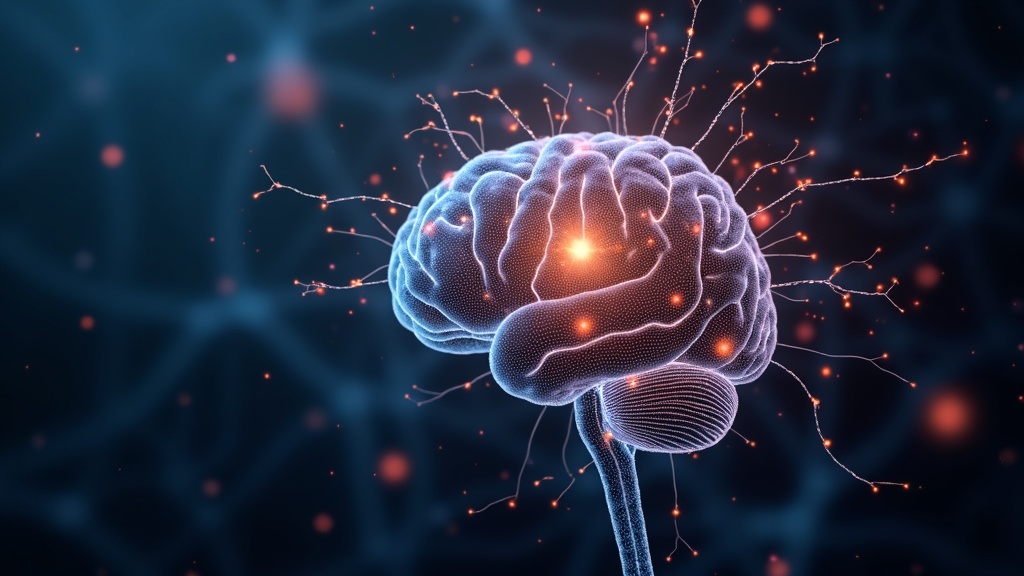Insights From Neuroscience
Here’s something that blew my mind when I discovered it: every time you sit down to meditate, you’re not just calming yourself temporarily. You’re triggering actual physical changes in your brain—changes that scientists can now see on MRI scans and measure in brain wave patterns. This isn’t about positive thinking or placebo effects. It’s neuroscience.

A Note About My Journey
BEFORE WE DIVE IN I want to be transparent with you: I’m not a certified meditation teacher or therapist. I’m someone who has experienced profound changes through consistent practice and become passionate about sharing what I’ve learned. My journey started from a place of desperate anxiety, and through meditation, I’ve built genuine confidence and peace that I never thought possible.
You can read more about my story and what drives this work on my About page. I share evidence-based information because I believe you deserve to understand the science behind practices that can truly help. But I always encourage working with qualified healthcare providers for personalized mental health support.
If you’ve been struggling with anxiety like I have, understanding what’s happening in your brain during meditation might be the motivation you need to stick with the practice. Because here’s the thing: you’re not just imagining the benefits. You’re literally sculpting a calmer, more resilient brain with every session.
Disclaimer: The information in this article is for educational purposes only and is not intended as medical advice. Meditation can be a valuable tool for managing anxiety, but it should not replace professional medical care. If you’re experiencing severe anxiety or other mental health concerns, please consult with a qualified healthcare provider or mental health professional. Individual results may vary, and what works for one person may not work the same way for another.
Your Brain Is More Flexible Than You Think
One of the most empowering discoveries in neuroscience is something called neuroplasticity—your brain’s ability to rewire itself throughout your entire life. For years, scientists believed our brains were fixed after childhood. They were wrong.
Every time you practice meditation, you’re taking advantage of this incredible feature. When you notice your mind has wandered and gently bring your attention back to your breath, you’re not just completing a meditation technique. You’re building new neural pathways that make it easier to shift your attention away from anxious thoughts the next time.
Think of it like going to the gym. You wouldn’t expect visible muscles after one workout, but consistent training builds strength over time. Your brain works the same way. The anxiety patterns that feel so automatic right now can be weakened while you simultaneously build stronger pathways for calm and resilience.
What Actually Changes in Your Brain
Gray Matter Grows in the Right Places

Brain scans reveal that meditation literally increases gray matter density in specific regions, including the hippocampus (important for learning and memory) and structures associated with self-awareness, compassion, and introspection.
The prefrontal cortex—your brain’s CEO that handles decision-making and emotional control—gets thicker with regular practice. This matters tremendously for anxiety because a stronger prefrontal cortex means you have better control over your emotional responses. It’s like upgrading your brain’s operating system.
Here’s the part that really stands out: these changes appear after just eight weeks of consistent practice, with participants spending an average of 27 minutes each day on mindfulness exercises. That’s less time than most of us spend scrolling social media.
Your Internal Alarm System Gets Less Sensitive
Here’s where things get really interesting. The amygdala is a small, almond-shaped structure deep in your brain that acts as your anxiety alarm. It’s constantly scanning for threats and triggering those uncomfortable fight-or-flight responses that make your heart race and your thoughts spiral.
Studies show that reductions in stress from meditation correlate with decreased gray matter density in the amygdala. A smaller, less reactive amygdala means fewer false alarms throughout your day. It’s like turning down the sensitivity on your internal security system so it doesn’t go off every time a leaf blows by.
Even better? These changes persist beyond your meditation sessions. Your amygdala stays calmer all day long, which explains why regular meditators tend to react less intensely to stressful situations.
Building a Bridge Between Logic and Emotion

One of the most frustrating parts of anxiety is knowing rationally that you’re safe while still feeling terrified. That disconnect happens when your prefrontal cortex (rational brain) and amygdala (emotional brain) aren’t communicating effectively.
Meditation strengthens the pathways between these regions, creating better “top-down” control. Your thinking brain becomes more skilled at calming your emotional brain. It’s like building a stronger bridge so messages can travel more efficiently between the two sides.
This is what allows you to eventually “talk yourself down” from anxiety more successfully. Not through force or willpower, but through actual structural changes in how your brain regions connect.
The Chemistry of Calm
Beyond structural changes, meditation transforms your brain chemistry in powerful ways:
- Research from Boston University School of Medicine found that mindfulness practices can increase GABA (your brain’s calming chemical) levels significantly—one study showed up to 27% increase after 60 minutes of practice
- Levels of dopamine, serotonin, and GABA all rise in response to meditation, and in people who practice daily, these neurotransmitters send signals more routinely
- Cortisol, your primary stress hormone, decreases significantly with regular practice—one study found a 25% reduction after six months of meditation training

These aren’t just temporary states during meditation. Your brain chemistry naturally shifts toward calmer, more balanced states that persist throughout your day.
The Early Warning System You Didn’t Know You Had
The insula is a fascinating part of your brain that helps you sense what’s happening inside your body—your heartbeat, breathing pattern, muscle tension. Meditation increases the size and connectivity of your insula, which means you become more aware of anxiety symptoms earlier, when they’re easier to manage.
For me, this has been game-changing. I now notice the subtle tightness in my chest or the slight quickening of my breath before they escalate into full-blown anxiety. That early detection gives me time to intervene with breathing exercises or a quick body scan before panic sets in.
Your Mind Wanders Less (Seriously)
You know that mental chatter that keeps you up at night? The endless “what-if” scenarios and replaying conversations from three years ago? That’s your Default Mode Network (DMN) at work—a collection of brain regions that activate when your mind wanders.
Meditation decreases DMN activity and connectivity. Experienced meditators show permanently reduced DMN activity even when they’re not actively meditating. Your mind literally becomes less prone to spinning anxious stories about things that haven’t happened and probably never will.
The Timeline: What to Expect and When

Understanding the progression of changes helped me stay motivated during those early weeks when I wasn’t sure if anything was happening:
After a single session:
- Immediate increase in calming alpha brain waves
- Decreased cortisol levels
- Reduced amygdala activation
- Better heart rate variability
After 2-4 weeks:
- Improved attention control
- Noticeable reduction in rumination
- Better emotional regulation in daily life
After 8 weeks:
- Clear increases in gray matter in key regions
- Measurable amygdala size reduction
- Significant improvement in anxiety symptoms
- Stronger connections between brain regions
After 6+ months:
- Substantial structural reorganization
- Baseline brain activity permanently altered
- Anxiety resilience becomes trait-like (not just temporary)
- Your brain operates more efficiently, using less energy for the same tasks
Why This Matters for Your Anxiety Journey
When I first learned about these brain changes, something shifted in my perspective. I stopped seeing meditation as just another self-help trend and started understanding it as actual brain training. Every session was building something real and lasting.
Research shows your brain has the potential to change with practice. These benefits accumulate over time—the longer you practice, the more your brain adapts. And here’s the best part: results transfer into daily life. You’re not just calm during meditation; you’re developing a fundamentally less reactive nervous system.
Consistency matters more than perfection. Regular short sessions beat occasional long ones every time. Even 10-15 minutes daily creates meaningful change. If you’re just starting out, you might want to read my other article about what meditation is and how it helps with anxiety to understand the basics.
Getting Started (Or Staying Consistent)

If you’re new to meditation, start small. Five minutes counts. Sit comfortably, close your eyes, and focus on your breathing. When your mind wanders (and it will—constantly at first), gently bring your attention back. That simple act of returning your focus is where the magic happens.
If sitting in complete silence feels overwhelming at first, that’s completely normal. Many people find guided meditations incredibly helpful when starting out—having a calm voice walk you through the process can make it easier to stay focused and feel less alone in the practice. Apps like Insight Timer, Calm, or Headspace offer thousands of free guided sessions. Alternatively, meditation music or nature sounds (like rain, ocean waves, or gentle instrumental music) can provide a soothing backdrop that helps quiet the mental chatter without being distracting. There’s no “wrong” way to meditate—the goal is finding what helps you stay present and return to the practice consistently.
Quick-Start Tips:
- Choose the same time each day to build a habit
- Start with just 5-10 minutes
- Use guided meditations if that feels more comfortable
- Try meditation music or ambient sounds if silence feels too intense
- Don’t judge yourself for having a “busy mind”—that’s completely normal
- Track your sessions to watch consistency build over time
- Remember: every single session is rewiring your brain, even when it feels like “nothing is happening”
The most important thing I’ve learned? You don’t need to feel immediate results for the work to be happening. Your brain is changing whether you feel it or not. Trust the process and stay consistent.
Frequently Asked Questions

How long does it take to see results from meditation?
Some people notice improved calm and focus within a few days, but measurable brain changes typically appear after 8 weeks of regular practice (20-30 minutes daily). That said, benefits start accumulating from your very first session—your brain begins adapting immediately.
What if my mind won’t stop racing during meditation?
That’s completely normal and doesn’t mean you’re “doing it wrong.” The racing thoughts are exactly why you’re practicing. Each time you notice your mind has wandered and bring it back to your breath, you’re strengthening those neural pathways. That’s the exercise.
Can meditation replace anxiety medication or therapy?
Meditation is a powerful tool, but it’s not a replacement for professional treatment. Think of it as a complementary practice that enhances other treatments. Always work with your healthcare provider about your treatment plan.
What’s the best type of meditation for anxiety?
Mindfulness meditation and focused attention practices (like breath awareness) have the most research supporting their effectiveness for anxiety. Start with what feels most accessible and comfortable for you.
Will I lose the benefits if I stop meditating?
Some structural changes can persist, but the benefits are strongest with ongoing practice. Think of it like physical fitness—you maintain your strength by continuing to exercise. The good news is that even if you take a break, your brain will respond quickly when you resume.
The Bottom Line
Your brain is incredibly adaptive, and meditation is one of the most powerful tools for directing that adaptability toward greater peace and resilience. The anxiety patterns that feel so ingrained right now are not permanent. They’re just well-practiced neural pathways that can be weakened while you simultaneously build stronger pathways for calm awareness.
Every time you sit down to meditate—even for just a few minutes—you’re participating in a remarkable process of neural transformation. You’re not just managing symptoms; you’re reshaping the very structure and chemistry of your brain.
The research is clear, the timeline is proven, and the practice is accessible to everyone. The only question is: are you ready to start building a calmer brain today?
I’d love to hear about your experience with meditation. Have you noticed changes in how your brain responds to stress? Are you just starting out and feeling skeptical like I once was? Drop a comment below and share your journey—your struggles, your wins, or your questions. We’re all learning together.
With love, Deeana — Meditate4Calm





